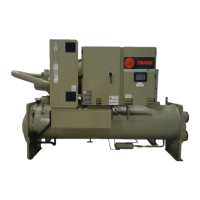28
RTHD-SVX01L-EN
General
Note: Field piping must be arranged and supported to
avoid stress on the equipment. It is strongly
recommended that the piping contractor provide at
least 3 feet (914 mm) of clearance between the pre-
installation piping and the planned location of the
unit. This will allow for proper fit-up upon arrival of
the unit at the installation site. All necessary piping
adjustments can be made at that time. Refer to the
current engineering bulletin for further details on
installation.
• Where specified, supply and install valves in the water
piping upstream and downstream of the evaporator and
condenser water boxes, to isolate the shells for
maintenance and to balance/trim the system.
• Supply and install condenser water control valve(s) per
Engineering Bulletin RLC-PRB017*-EN, for Condenser
Water Temperature Control Optimus™ Water-Cooled
Chillers..
• Supply or locate ship-with flow switches. Install flow
switches or equivalent devices in both the chilled water
and condenser water piping. Wire the flow switches into
the control system as indicated on the electrical
schematics and field wiring diagrams, to ensure that
the unit can only operate when water flow is
established.
• Supply and install taps for thermometers and pressure
gauges in water piping, adjacent to the inlet and outlet
connections of both the evaporator and the condenser.
• Supply and install drain valves on each water box.
• Supply and install vent cocks on each water box.
• Where specified, supply and install strainers ahead of
all pumps and automatic modulating valves.
• Supply and install refrigerant pressure relief piping from
the pressure relief to the atmosphere.
• If necessary, supply enough refrigerant and dry
nitrogen (75 psig) for pressure testing.
• Where specified, supply and insulate the evaporator
and any other portion of the unit, as required, to prevent
sweating under normal operating conditions.
Piping Connections
NOTICE
Pump Damage!
Failure to follow instruction could result in pump
damage.
If using any commercial flushing/cleaning solution,
construct a temporary bypass around the unit to
prevent damage to internal components of the
evaporator/condenser. Trane assumes no
responsibility for equipment damage caused by
flushing/cleaning solutions or water-borne debris.
Make water piping connections to the evaporator and
condenser. Isolate and support piping to prevent stress on
the unit. Construct piping according to local and national
codes. Insulate and flush piping before connecting to unit.
Use grooved pipe connectors for all water piping
connections. Evaporator and condenser water inlet and
outlet sizes and locations are shown by the unit submittals.
The designation in the tables corresponds to the
compressor frame code followed by the evaporator shell
code followed by the condenser shell code as given in the
unit model number, digits 6, 7, 14, 15, 21 and 22. Table 1
through Table 3 list water connection information.
Reversing Waterboxes
All water boxes may be reversed end-for-end. See
“Cleaning the Condenser,” p. 68 for detailed waterbox
removal instructions.
Remove sensors from wells before removing waterbox.
Do not rotate water boxes. See Figure 14, p. 29 through
Figure 16, p. 30 for correct orientation of the water inlet
and outlet.
Complete the water box switch and replace sensors.
Notes:
• If water boxes are reversed, be sure to properly
rewire water temperature sensors in control
panel.
• Be certain to replace water boxes right-side-up
to maintain proper baffle orientation. Use new
o-rings.
Installation Mechanical

